 Short Communication
Short Communication
Louis Brier Home and Hospital Rapid Improvement Events: Kaizen and 5S
Louis Brier Home and Hospital Rapid Improvement Events: Kaizen and 5S.
Received Date: January 16, 2019; Published Date: February 25, 2019
Short Communication
About Louis Brier
A public long-term care facility serving Vancouver’s Jewish community, funded by the Vancouver Coastal Health Authority, and supported by the Jewish Foundation. The Louis Brier Home and Hospital offers resident and family centered care. Many programs and services are offered: nursing, dietary and food services, rehabilitation, recreation, companion and volunteer to name a few (Figure 1).
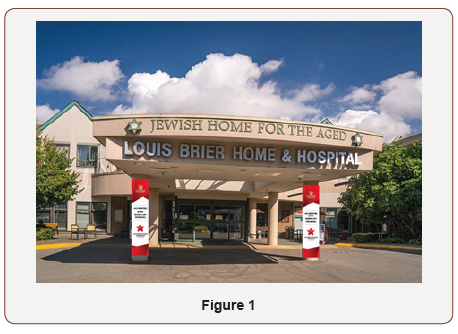
Louis Brier’s vision and mission are aimed at providing the best care possible to its residents while striving to be recognized as a Center of Excellence in elder care. Achieving accreditation status was one of the milestones set by the board and the leadership team of Louis Brier, however it is just the start. In order to achieve culture change, engage in continuous quality improvement, and engage in innovation and creativity, the leadership team in collaboration with the board decided to apply the principles and framework of LEAN to the everyday work and activities at Louis Brier. Together with external experts, we embarked on our LEAN journey rolled out our first Kaizen and 5S events throughout the months of September and October.
Kaizen Event-Nursing Model of Care
“One approach to continuous, incremental improvement is called kaizen. It originated in Japan and the word translates to mean change (kai) for the good (zen).”1 Our first Kaizen event took place during the week of June 25th to 29th, 2018; focusing on the Nursing Model of Care. This was a five-day event, led by an experienced Lean Sensei Michael Elias. This a Rapid Improvement Event that included heavy engagement by front line staff and leadership. The purpose was to radically and permanently improve processes to enhance the resident experience. The event included three weeks of preparation and three months of follow up and sustainability.
Senior leadership and managers empowered frontline staff to make “subtle, on-going changes and continuous improvement”,2 to the Nursing Model of Care. We trialed a new way of delivering care to our residents team -based approach. We identified gaps in our process, work-flow and communication tools. We addressed the issues in real time. The project addressed the continuous complaints of heavy workload, low morale, lack of teamwork / communication and inconsistency of work amongst nursing unit. We worked towards achieving a team-based approach, maintaining licensing standards, addressing inconsistencies in practice as well as, adhering to Work Safe BC regulations.
Foot Note:
1“Kaizen: Gaining the Full Benefits of Continuous Improvement,” The Mind Tools Content Team, https://www.mindtools.com/pages/article/newSTR_97. htm
2“Kaizen: Gaining the Full Benefits of Continuous Improvement,” The Mind Tools Content Team, https://www.mindtools.com/pages/article/newSTR_97. htm
During the process, we changed the Activities of Daily Living (ADL) communication tool as a way to improve our communication strategies. We determined TAKT times (the average time between the start of production of one unit and the start of production of the next unit) and learned about level loading (a LEAN technique to even out the workload) between nurses and Care Aides (CA). Nurses can assist CAs by answering call bells, feeding and helping with transfers. Our goal is to improve the challenges around continuity of care, and the development of standard work for each discipline, Registered Nurses (RN), Licensed Practical Nurses (LPN) and CAs.
Pilot Unit
All “employees are responsible for identifying the gaps and inefficiencies and everyone, at every level in the organization, suggests where improvements can take place.”3 A team of frontline staff developed many solutions. These solutions were tested on one pilot unit out of a total of 7 units. We requested frontline staff to be patient and provide daily feedback. This experiment ran for three 3 weeks before we rolled out to the rest of the organization. The implementation required staff cooperation and commitment as we worked together to adapt to the change. We were successful in achieving our goals. Staff now have timely breaks, finish work on time and have strong support from our leadership resulting in an enhanced resident experience.
Quote from a Louis Brier Care Aide
“As a front-line CA, all I can say is that Kaizen event was a huge success. What makes me say this? Because disappointments and complaints from residents and families were mitigated. We were able to provide the needs of our residents on their requested time and give more attention to them. Residents were distributed evenly according to their geographical locations. Workload was evenly distributed among staff. Staff were able to have their breaks on time. My hope is that we will be able to sustain this change.” Lucia Africa CA.
5S Event
On our rapid improvement journey, we held a 5S Event focusing on supply chain management as it relates to Nursing Stations, Medication Rooms, Supply Rooms, Shower Rooms and Resident Rooms. “5S implementation helps to… eliminate waste and maintain a clean work environment.”4 Staff members from different disciplines were invited to participate in this education; to help us identify our current practices and develop new standardized workflow. The Supply Management initiative will compliment and build on our Kaizen initiative to better utilize our supplies and equipment.
It was projected that these improvements to the nursing stations, medication rooms, and supply rooms would cost up to $60,000 over 3 years for 6 units. The total cost was as follows:
1. Nursing Station - $0 (used existing storage cabinets and folders).
2. Medication Room - $4 (zip lock bags to store resident’s creams).
3. Supply Room - $1200 (rolling chrome wire metal carts and bins) (Figure 2).
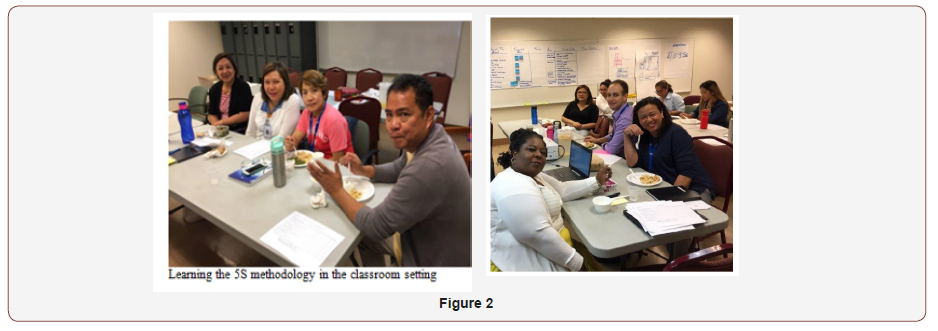
The 5S Methodology is a standardized process that creates and maintains an organized, safe, clean and efficient workplace. This initiative helped us examine our current process of how we order, store and use supplies (e.g. wound dressing, laundry, incontinence products, etc.) and develop a standardized supply management process. The ultimate goal was to identify wastes and to eliminate them.
Five “terms represent the five steps toward operational and process excellence.”5
The process used in this initiative are:
a. Sort: Separating of the essential from the non-essential items.
Foot Note
3“Kaizen: Gaining the Full Benefits of Continuous Improvement,” The Mind Tools Content Team, https://www.mindtools.com/pages/article/newSTR_97. htm
4Luciana Paulise, “Implementing the 5S Methodology: The First Steps Toward Workplace Efficiency,” https://www.simplilearn.com/implementing-5smethodology-to-achieve-workplace-efficiency-article, (July 6th, 2018).
5Luciana Paulise, “Implementing the 5S Methodology: The First Steps Toward Workplace Efficiency,” https://www.simplilearn.com/implementing-5smethodology-to-achieve-workplace-efficiency-article, (July 6th, 2018).
b. Set to order: Organizing the essential materials where everything has its place.
c. Shine: Cleaning the work area.
d. Standardize: Establishing a system to maintain and make 5S a habit.
e. Sustain: Establishing a safe and sanitary work environment (Safety).
The project result will promote efficiency by decreasing footsteps and providing staff with the right tools when they need them in order to provide the best care possible.
Pilot Unit
We conducted a series of activities in one pilot unit focusing on the nursing station, medication room, supply room, shower room and residents’ rooms.
Nursing Station
Team
Carol Bucknor, Nicole Encarnacion, Angela Millar, Jonna Gutierrez, Jeannette Aldaba, Divina Buenaventura, Rizwan Shawl, Alex Portnik and Tazim Esmail.
The team decided to remove the filing cubby that contains all the forms as it interferes with the line of sight between staff and residents. We removed and sorted through all the forms from the cubby. All the outdated forms were removed. We created a finalized list of forms that would be stored in a filing cabinet under the nursing station desk. The forms were labeled and organized in alphabetical order. We used all the available materials/supplies that were around the building (filling cabinet, hanging folders, tabs). We spent $0 for organizing our forms. Care staff have reported that the forms are easily accessible and that they no longer have to email the Clinical Nurse Leaders (CNL) for forms or requisitions. Our goal is to create a FORM folder on all desktop computers with PDF fillable forms by the end of October 2018.
Charts, binders and clipboards were all found on the nursing unit desk. It made the space look very untidy and disorganized. Many of the drawers on the desk were unused and care staff were storing unnecessary items in them. We decided to remove all the drawers that were not being utilized and to use it to store the binders and books. We left two drawers for stationary supplies and the rest of the drawers were removed and left open for binder storage. Residents’ charts remain in the cabinet, however we asked maintenance staff to remove the doors so that the interdisciplinary team can easily spot the charts they need (Figure 3).

Medication room
Team
Alex Portnik, Nicole Encarnacion, Roemilyn Tanaquin, Jeannette Aldabaand Divina Buenaventura.
The team followed the 5S principles by going in the medication room. We sorted through items using labels wastes and opportunities. The old fax machine and table were disposed of. The narcotic return box was relocated from the floor to one of the empty cupboards beside the door. There was an excess of nursing supplies. Needles, syringes and three empty sharps containers were returned to the stores department. The diabetic needles were returned to Clinical Nurse Leaders. Many non-nursing items were also discarded.
We asked the maintenance staff to remove all cupboard doors except for two. Removing the cupboard doors allows the nursing team to quickly identify where items belong. The Nurse Initiated Orders, Pre-Printed Orders, Anaphylactic and Naloxone kits were all moved to the one remaining locked cupboard. Residents’ creams were individually placed and labelled in Ziploc bags and stored in specific plastic containers marked for south and north teams. We have decided on the PAR level of ten pieces for nursing supplies and to control the reordering of refill meds (only reorder when one or two doses left). The only cost incurred was the Ziploc bags for the creams.
There were many care aides supplies and nursing supplies that were moved from the medication room to the supply room. After sorting the items, the group discussed and agreed upon where to set the remaining supplies. Each supply had its own drawer: needles/ syringes, diabetic supplies, palliative supplies and nail clippers and rechargeable shavers. The main goal for the team was to ensure that when a nurse walks into the medication room everything is not only easily visible but also readily accessible. All drawers and cupboards (used and empty) were cleaned and shined. Then, we made labels for each drawer and shelf. Instructions were added where needed. Cupboard shelves were repositioned diagonally to the empty spaces in order to prevent staff from putting unnecessary items in it. The maintenance staff made us boxes to fill in the space of the unused drawers. One cupboard was left open for nurses to place their belongings.
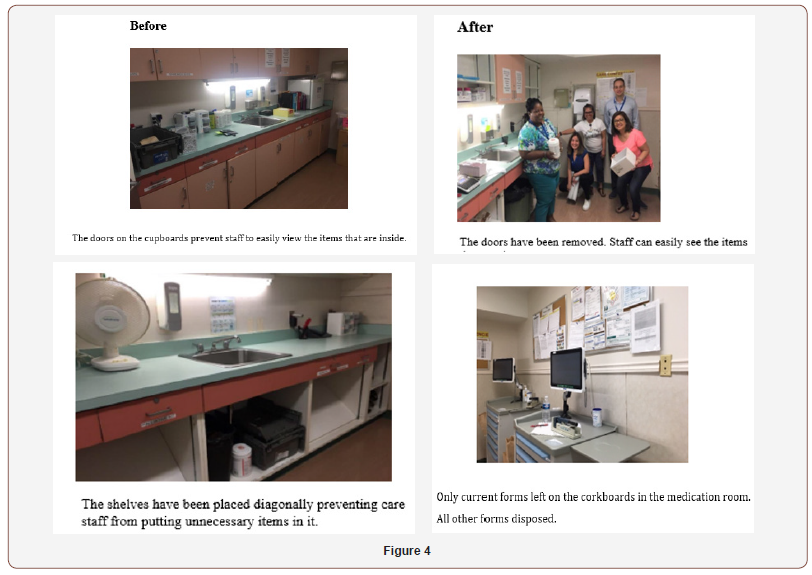
The medication fridge was moved from the far corner of the room to the counter above the narcotic return box which is closer to the door. This was done for clear visibility and easy access. The tablet batteries were stationed to the far end counter. There were three binders for narcotic return and medication received sheets. We were able to put all forms into 1 binder with labelled dividers. There were three soap dispensers on the wall that were removed and disposed. The memos and information sheets on the cork/ white boards were updated. Only the current memos were left on the boards. Staff have commented, about the medication room, “Wow it’s so bright”, “Oh my! the place is bigger and so clean,” “How are we going to maintain this? “The team must do weekly audits to maintain and sustain this change. Must continually educate and remind all nurses (Figure 4).
Supply Room
Team
Jennifer Belen, Jay Santos, Tazim Esmail, Lunadel Dacaln,Gabriel Dela Cruz and Dylan Xu.
“Speaking from the stores point of view, the 5S methodology was very informative. We were able to incorporate the principles that will assist in providing efficient storing, distributing and ordering of supplies. As with any new system there is a slight learning curve. Having the right information will help make the stores department work easier and prevent waste.”-Jay Santos. Speaking of waste - after bringing down the unnecessary items from Hospital East we tallied the amount which came to $2,600! The changes we have implemented will help to reduce waste in the future.
After removal of the old counters and shelves, two new rolling chrome wire carts (with six shelves on each cart) were installed at a cost of just over $1,000.00. Approximately $200.00 was spent on bins excluding supplies such as laminating sheets and labeling tape. We did notice that par levels needed to be adjusted especially with fast moving items such as the medical towels, drinking and medicine cups, cream wash and teaspoons.
The 2 bin Kanban system was created as a planning system. The aim was to optimally control and manage work and inventory at every stage of supply chain management. Supply carts were all properly labelled. Each plastic bin was labelled with a picture of the item, bin number and par level. When the stock in a bin is finished, the empty bin gets placed at the top of the rolling chrome cart which signals for stores to replenish the stock. Behind the original plastic bin there is a buffer stock that can be used until stores restocks the supply.
We worked on the menu posters for both carts so that staff could easily locate the supplies they were looking for. The menu has a picture of the supply as well as the bin number. We marked with floor of the supply room with red tape identifying the home base for each piece of equipment (BP machine, portable oxygen, oxygen concentrator, bladder scanner, outbreak drawer). The names of each piece of equipment were adhered to the floor. Signage was also taped next to each piece of equipment. We have received positive feedback from staff members who appreciated the streamlined look of the items stocked on the new shelves. They also find it easier locating medical machines. Care staff find that the changes made to the supply room is saving them a lot of time and energy. Previously, it was always difficult to find supplies and equipment. Now the process is more efficient..
In order to sustain the changes, everyone must do their part in keeping with the program that has been implemented. Audits “can make sure the 5S are sustained…and everyone is following procedures.”6 To do this we must have regular huddles, be open to feedback and monitor the medical carts/shelves daily to ensure that the 2 bin Kanban system is being used effectively (Figure 5 & 6).
Foot Note
6Luciana Paulise, “Implementing the 5S Methodology: The First Steps Toward Workplace Efficiency,”https://www.simplilearn.com/implementing-5smethodology-to-achieve-workplace-efficiency-article, (July 6th, 2018).
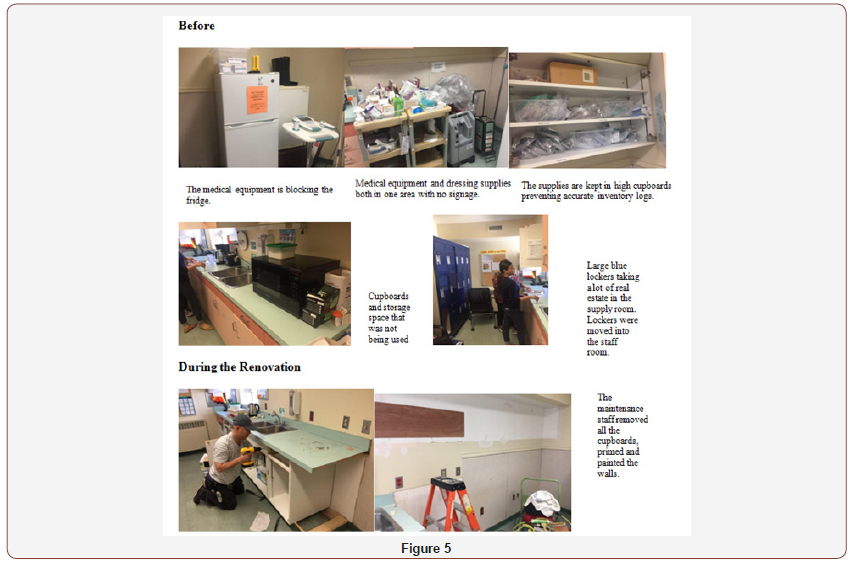
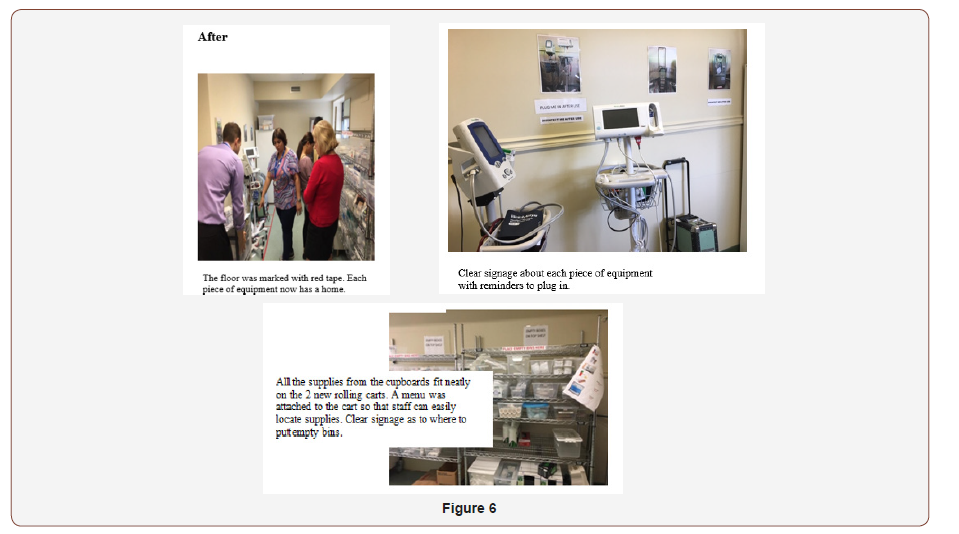
Shower Room and Residents’ Rooms
Shower room
Frequently used items were identified; like CA carts, sit to stand machines, commodes, bath trollies and weighing scales. Categorizing was completed according to type. Labels were made and displayed on the walls and assigned a fixed area. A request was put through to Worx Hub (the portal for work orders) for painting on the floor as a dividing line in order to know the exact locations of where equipment was to be placed after each use. We provided two small baskets with labels. The first basket was for body wash cream and lotion. The second basket was for oxygenic and deodorizer. A small labeled bench for residents’ clean personal belongings was also provided. Dirty linen bins and personal clothing bins were labeled in order to avoid confusion. Slings were labeled according to their sizes. An ergonomic design was created for incontinent brief storage. A bin with a plastic liner was provided and placed in the hopper room. Soiled items should be placed in a small clear bag before putting them in the labeled bin (Figure 7).
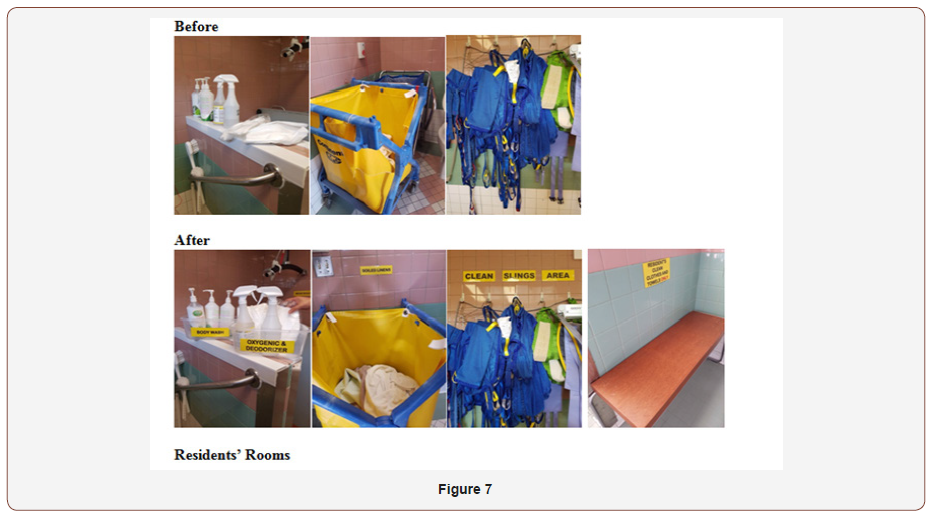
Residents’ Rooms
Residents’ rooms team members
All residents were provided baskets for each of their washrooms with their names on them. Attached to each basket was a list of the items that were to be inside. Wash, wipes and lotion were included. In this way, we can all work “together to define ways to standardize the improvements over time.”7
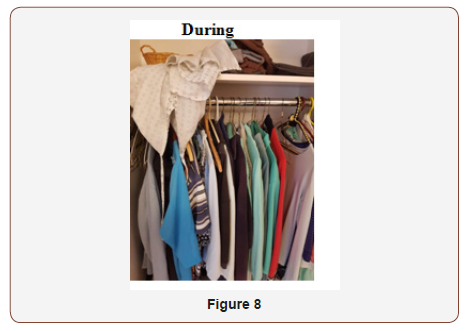
Each resident’s room has at least 2 slings. Hand washing technique was displayed above sinks in the residents’ rooms. We organized the residents’ closets according to the frequency of use. Shirts and pants were all hung up so that they were visible to residents and care staff. Jackets and sweaters were hung behind the shirts and pants in order to keep order (Figure 8 & 9).
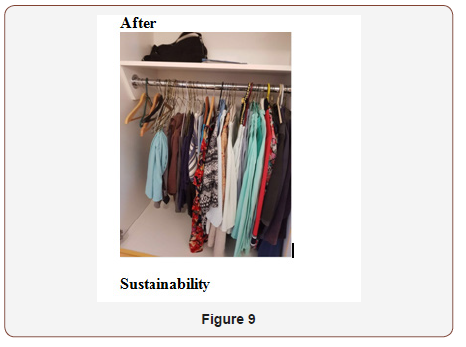
Sustainability
“Make 5S part of [our] culture and incorporate it into the corporate philosophy. Build organizational commitment so that 5S becomes one of [our] organizational values so that everyone develops 5S as a habit.” ”8
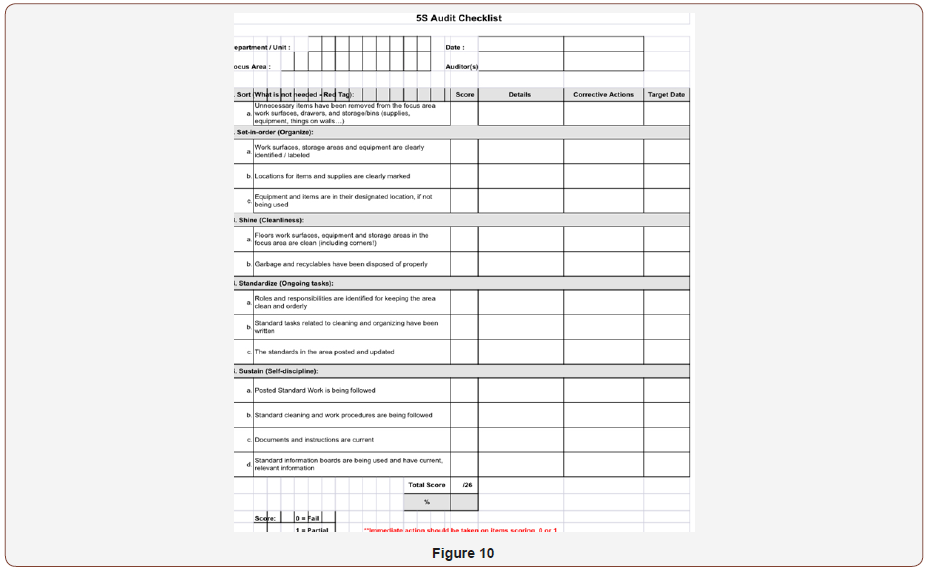
5S Audit Checklist created by Lunadel Daclan
Foot Note
7Luciana Paulise, “Implementing the 5S Methodology: The First Steps Toward Workplace Efficiency,” https://www.simplilearn.com/implementing-5smethodology-to-achieve-workplace-efficiency-article, (July 6th, 2018).
8Luciana Paulise, “Implementing the 5S Methodology: The First Steps Toward Workplace Efficiency,” https://www.simplilearn.com/implementing-5smethodology-to-achieve-workplace-efficiency-article, (July 6th, 2018).
This process is sustainable if we do the following
a. Regular audits (see audit checklist below) (Figure 10).
b. Continue to collect feedback from staff.
c. We need to encourage staff to adhere to the 5S principles.
d. All levels of Management must show commitment to follow through.
Post Event Education
The 2-day post event education included the Senior Leadership Team and keen frontline staff. It was a select group of people, who would become the organization’s LEAN leaders/experts. This group of individuals are responsible for ensuring that our process improvement work in the organization continues to thrive, provide updates, and keep everyone on track in terms of meeting deadline, schedules, and action items.
A LEAN/Kaizen steering committee was established along with Terms of Reference. A third event will take place in the New Year, and should be scheduled for May 2019, and will focus on food services.
Our goal at Louis Brier Home and Hospital is to be the Centre of Excellence in nursing care. We have high standards and provide resident and family centered care. Our CEO David Keselman is strongly committed to ensuring that the rapid improvement events are maintained and sustainable through regular huddles and audits. These events permanently improve processes and in turn resident experience and staff morale. “There is always room to make small improvements, challenge to status quo and tune processes.” A special thank you to Jay Santos, Lucia Africa, Shirley Harrison, Jonna Gutierrez, Divina Buenaventura and Michael Galope for providing the photographs that documented our journey. We are appreciative of each team for the work that they’ve done and the information that they have contributed to the article.
Acknowledgement
None.
Conflict of Interest
No conflict of interest.
-
Tazim Esmail. Louis Brier Home and Hospital Rapid Improvement Events: Kaizen and 5S. Iris J of Nur & Car. 1(2): 2019. IJNC. MS.ID.000510.
-
Rehabilitation, Recreation,; Kaizen; Kaizen Event – Nursing Model of Care; Licensed Practical Nurses; Registered Nurses; Pilot Unit; Worx Hub ;
-

This work is licensed under a Creative Commons Attribution-NonCommercial 4.0 International License.






